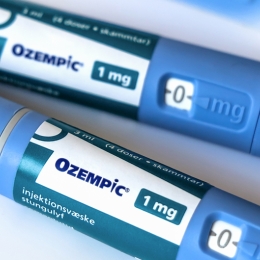How to reverse prediabetes & type 2 diabetes
Fifteen percent of U.S. adults have diabetes. Another 38 percent have prediabetes (and 8 out of 10 of them don’t know it). Together, that comes to 1 in 2 adults with harmful blood sugar levels. The good news: Many cases can be prevented and, in some people, even reversed. Here's what to know.
1. Got prediabetes? You can prevent type 2 diabetes.
The news hit in 2002. That’s when researchers at 27 sites nationwide reported the results from the Diabetes Prevention Program. For nearly three years, the DPP had randomly assigned 3,234 people with prediabetes to an “intensive lifestyle intervention,” a diabetes drug called metformin, or a placebo.
“The lifestyle intervention reduced the risk of type 2 diabetes by 58 percent, and metformin reduced the risk by 31 percent compared to those who got a placebo,” says Dana Dabelea, professor of epidemiology and pediatrics at the University of Colorado.
The lifestyle intervention had two parts. “It focused on reducing dietary fat intake and promoting at least 150 minutes of physical activity per week, with a goal of meeting a weight-loss target of about 7 percent,” says Dabelea.
Why eat less fat? It helped people cut calories.
“It was really about weight loss,” explains Dabelea. “A later analysis estimated that a weight loss of 5 kilograms—11 pounds—accounted for about a 60 percent reduction in the risk of diabetes.” (The average participant started the trial at roughly 200 pounds.)
“And people who had more than the average 7 percent weight loss and met their physical activity goals—they reduced their diabetes risk by 90 percent.”
“This was one of the first papers to suggest that type 2 diabetes can be not just delayed but prevented.”
Exercise plus weight loss can help prevent type 2 diabetes
Exercise helped, even if participants didn’t hit their weight-loss target.
“Those who met the goal of at least 150 minutes of physical activity a week reduced their risk of diabetes by 44 percent, even if they didn’t lose 7 percent of their initial weight,” notes Dabelea.
“So physical activity might help prevent diabetes above and beyond weight loss, although weight loss is the most important component.”
“The message of the DPP is that if you lose weight, you’re going to substantially reduce your risk of diabetes.”
It’s not just the DPP. The Finnish Diabetes Prevention trial and the Da Qing Diabetes Prevention Study in China had similar results.
What does it take to put type 2 diabetes in remission?
Greater weight loss can drive type 2 diabetes into remission in some people.
In 2019, the DiRECT trial reported that among people who were randomly assigned to lose about 30 pounds with a very-low-calorie liquid formula diet, 46 percent no longer had blood sugar levels in the diabetes range after a year. (Some of the study’s authors had ties to the companies that sold the formula.)
But the weight often comes back. That’s why physicians are excited about new drugs like Mounjaro (tirzepatide) and Ozempic (semaglutide), which may cut blood sugar not only by keeping weight off but by boosting insulin secretion and sensitivity. (Those drug studies were industry funded.)
“This new class of drugs is very promising for reverting to normal blood sugar and treating obesity,” says Dabelea. “It’s early, but the drugs offer new hope for people with type 2 diabetes.”
2. Even prediabetes isn't harmless.
“Without weight loss and moderate physical activity, 15–30% of people with prediabetes will develop type 2 diabetes within 5 years,” says the Centers for Disease Control and Prevention.
But the goal isn’t just to keep people from crossing the line into diabetes, say researchers. It’s to reverse prediabetes—that is, to return blood sugar levels to normal.
Why? Excess blood sugar can harm the tiniest blood vessels in the eyes, kidneys, nerves, heart, and elsewhere in the body.
“Diabetes remains a leading cause of blindness, kidney failure, and amputations,” notes Dabelea.
And the damage can start early.
“The DPP and many other studies have shown that the risk of retinopathy, nephropathy, neuropathy, and cardiovascular disease increases when blood sugar is in the prediabetes range,” explains Dabelea.
The good news: A third of the DPP participants got their blood sugar down to normal during the three-year trial.
“They had a 50 percent lower risk of diabetes 10 years down the road,” says Dabelea. “And they had a lower incidence of microvascular and cardiovascular complications.”
Her takeaway: “Prediabetes is not benign.”

3. What's the best diet for prediabetes or type 2 diabetes?
What’s the best diet for people with prediabetes or type 2 diabetes?
“Everyone agrees that we should all cut back on added sugar and refined grain and eat lots of non-starchy vegetables,” says Christopher Gardner, professor of medicine at the Stanford University School of Medicine.
That’s the most recent advice from the American Diabetes Association, which Gardner co-authored.
The ADA also recommended “whole foods over highly processed foods” and, for those with diabetes, reducing carbs to keep a lid on blood sugar.
But cutting back on refined grains and added sugar isn’t exactly a piece of cake.
If you look at what Americans eat, animal protein, plant protein, saturated fat, monounsaturated fat, polyunsaturated fat, and high-quality carbs (whole grains, beans, whole fruits, and non-starchy vegetables) each supplies roughly 10 percent of our calories, notes Gardner.
“What’s the elephant in the room?” he asks. “It’s the low-quality carbs.”
That’s refined grains, added sugar, fruit juice, potatoes, and other starchy vegetables, which supply nearly 40 percent of our calories.
What the "Keto-Med" trial tested
“Some studies have tested a low-carbohydrate keto diet versus a crappy low-fat diet that’s high in white flour and added sugar,” Gardner points out.
But that stacks the deck against low-fat.
So his “Keto-Med” trial had 33 people with prediabetes or type 2 diabetes eat either a “Well-Formulated Ketogenic Diet” or a “Mediterranean-Plus” diet for 12 weeks and then switch to the other diet for 12 weeks, followed by 12 more weeks of eating whatever they wanted.
“Both diets had no added sugar or refined grain and lots of nonstarchy vegetables, and both were lower-carb, but the keto diet was extremely low,” explains Gardner.
What’s more, the keto diet replaced most of the carbs with fat, not protein.
“Some people think, ‘A keto diet is great—I can eat all the meat I want,’” says Gardner. “But if you eat too much protein, you’ll throw yourself out of ketosis.” (That’s when your body burns ketones instead of carbs for energy.)
Why? “Once you’ve met your protein needs, the body has no place to store the excess, so the protein gets converted to carbs,” explains Gardner.
“And protein triggers the release of insulin when you’re trying to keep your insulin down.”
The Mediterranean diet supplied plenty of healthy fats. “It had olive oil, avocado, nuts, and seeds,” says Gardner.
“But it was high in three things you can’t eat in keto: beans, fruits, and whole, intact grains. That’s the central question we were trying to answer: Do you need to avoid those foods?”


The impact of a Keto vs. Med diet on blood sugar, cholesterol, and more
The key result: Hemoglobin A1c—a long-term measure of blood sugar—didn’t differ between the two diets.
But that’s not the whole story.
“Hemoglobin A1c and weight dropped on both diets,” notes Gardner. The differences: Triglycerides dropped more on keto. “That doesn’t surprise me because you’re getting rid of so many carbs,” says Gardner. “And keto was worse for LDL—or ‘bad’—cholesterol.”
That’s not trivial, given that cardiovascular disease is the No. 1 killer of people with diabetes.
The keto diet had other downsides. “In the last 12 weeks, most people weren’t following the diets—especially the keto—anymore,” notes Gardner.
And when people did follow the keto diet, “they had lower intakes of folate, vitamin C, magnesium, and especially fiber,” he adds. “They weren’t deficient after 12 weeks, but that might have an impact long term.”
Gardner’s bottom line: “I don’t think it’s a wash. I don’t think there’s any reason to get rid of legumes, grains, and fruits when so many recommendations from the American Heart Association, World Health Organization, and others promote them. The evidence in favor of a keto diet just doesn’t overturn that advice, even for people with diabetes.”
4. It's too soon for a personalized diet to lower blood sugar.
“We’re using microbiome data to change the outlook of chronic disease—starting with type 2 diabetes,” says DayTwo’s website.
“Understand how food affects your body,” says Zoe, “the first of its kind to combine microbiome analysis, blood testing, food logging, and continuous blood sugar monitoring.”
It’s not just private companies like Zoe, which charges $300 for a test kit plus $30 to $60 a month for ongoing feedback.
The National Institutes of Health recently launched its “Nutrition for Precision Health, powered by the All of Us Research Program.”

What does “precision nutrition” mean to NIH?
“We’re talking about the goal of individualized and actionable dietary recommendations that will help people decide what, when, why, and how to eat, so that they can optimize their health or quality of life,” explains Holly Nicastro, program director in the Office of Nutrition Research, on NIH’s website.
(It’s too early to sign up for the Nutrition for Precision Health program. But anyone can join NIH’s All of Us study, which is “inviting one million people across the U.S. to help build one of the most diverse health databases in history” to tackle a raft of diseases.)
“For a person with type 2 diabetes, for example, precision nutrition may mean following a dietary pattern that minimizes blood glucose spikes and crashes,” suggests Nicastro.
However, she adds, “at this point, we don’t have a test that an individual can take to figure out exactly how they can eat to optimize health.”
Do personalized diets lower blood sugar or weight?
Researchers randomly assigned 204 adults with excess weight and prediabetes or type 2 diabetes to either a low-fat diet or a personalized diet that used DayTwo’s program to predict after-meal blood sugar levels based on each person’s microbiome (from stool samples) and other data.
“In numerous trials, the evidence suggests that a low-fat and low-carb diet are equally effective for weight loss,” says study author Collin Popp, an early stage investigator at NYU Langone Health’s Center for Healthful Behavior Change. (One of Popp’s co-authors served as a consultant for DayTwo.)
“We wanted to see if targeting individual blood sugar responses to certain foods would lead to greater weight loss compared to a low-fat diet.”
Why would blood sugar matter? According to some researchers, “high levels of blood sugar after a meal are shuttled off to make fat, so reducing them may ultimately reduce fat accumulation, which leads to weight loss,” explains Popp.
Yet in his study, after six months, weight loss was roughly the same—only about 8 pounds—in each group.
“The take-home message is that a personalized intervention that targets after-meal blood sugar is no more effective for weight loss than a low-fat diet,” says Popp.
Did the personalized diet help people lower blood sugar? That data hasn’t been published yet.
But a personalized diet based on DayTwo’s program did make a difference in a 6-month study done by other researchers in 225 people with prediabetes.
Hemoglobin A1c fell more in those who were randomly assigned to a personalized diet than in those who were told to eat a Mediterranean diet. (The study was funded by DayTwo and Janssen Pharmaceuticals, a DayTwo investor.)
What’s more, people on the personalized diet cut the time spent with their blood sugar levels over 140 by 80 minutes a day, while those who were told to eat a Mediterranean diet cut that time by only 20 minutes a day.
Why it's too soon for a personalized diet
Popp’s bottom line: “We’re still far from coming up with interventions in precision nutrition. There’s definitely potential, but we need more data.”
Gardner agrees. He’s a co-author of the PREDICT 1 study, which used the Zoe app to predict blood sugar levels. (The study was partly funded by Zoe.)
“PREDICT is finding that in the same person eating the same food, the blood sugar response is different based on how much you slept, how much physical activity you did, what food you ate before it, what time of day you ate it, and more,” says Gardner.
Where does that leave people with prediabetes or diabetes? It’s too early to say.
“Different diets might be better for different people,” says Gardner. “But boy, there’s room for a foundational diet that has what everybody agrees on: no added sugar or refined grain and lots of nonstarchy vegetables.”
10 tips to dodge type 2 diabetes
- Are you at risk for type 2 diabetes? Take the American Diabetes Association's 60-second quiz.
- The best way to dodge prediabetes or diabetes is to lose (or not gain) extra pounds.
- No diet leads to weight loss unless it helps you cut calories.
- Many "keto" ice creams, breads, waffles, cookies, candies, and cereals have no fewer calories than their regular versions.
- Cutting carbs—especially white flour, potatoes, juice, and sugary drinks—may help lower blood sugar even if you don’t lose weight.
- Replace unhealthy carbs with unsaturated fats like olive or canola oil, nuts, avocado, and fatty fish.
- Fill half your plate with non-starchy vegetables.
If you have type 2 diabetes, don’t try a very-low-calorie or a low-carb diet without a doctor’s help. They may cause dangerously low blood sugar, and your doctor may need to adjust your medications.
- If you have prediabetes, find a CDC-recognized in-person or online Diabetes Prevention Program.
- Aim for at least 30 minutes of brisk walking or other aerobic exercise daily
Continue reading this article with a NutritionAction subscription
Already a subscriber? Log in
More on diabetes
How heat waves can kill...and how to stay safe
Preventing Disease

Take our quiz to help you stay healthy
Preventing Disease

Does too little sleep make your insulin less effective?

What to know about buying meds online
Fact vs. Fiction

Will extra protein help lower your blood sugar if you have diabetes?
Healthy Eating


